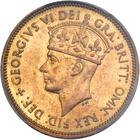Information about legend: + GEORGIVS VI DEI GRA: BRITT: OMN: REX FID: DEF:
| Legend | + GEORGIVS VI DEI GRA: BRITT: OMN: REX FID: DEF: |
|---|---|
| Full text | GEORGIVS VI DEI GRATIA BRITANNIARUM OMNIUM REX FIDEI DEFENSOR |
| Translation | Translated from Latin: George the Sixth, by the Grace of God, King of all the Britains, Defender of the Faith. |
|
This legend was displayed on British colonial coinage near the end of George VI's reign, when the reference to his being "Emperor of India" had to be dropped due to the Independence of India. The cross was used on Medieval English coins to assist in reading the (somewhat cryptic at the time) legends by showing where the legend starts. Later, some other symbols were also used in its place serving also the role of mint marks. The "BRITT OMN" part is sometimes translated as "of all the Britons" (people), similar to how earlier monarchs were styled kings "of the English"; however, this can only be said of a title like "BRIT REX" - King of the British - which implies "all the British". In 1868, a book by C. W. Dilke popularised the phrase "Greater Britain" to mean Britain and all its colonies. This may have led to the proposal of the title "King of all Britains", in the last years of the 19th century, by the Earl of Rosebery. The Oxford English Dictionary provides two quotes: 1897 Earl of Rosebery in Daily News 5 July 4/5 : "`Regina Britanniarum' - the Queen of the Britains... She is sovereign, not of one or two, but of numberless Britains, all self-supporting." This style may have been influenced by the Russian style of "Czar of all the Russias". It appeared on coins abbreviated as Britt. Omn.: the double T in Britt is a mark of plural, a common abbreviation on Roman coins. | |
| Country | Coin Name | Reverse | Obverse | Details |
|---|---|---|---|---|
| British West Africa | One Shilling 1949 |  |
 |
Material: Tin Brass Mints: - Royal Mint: 70,000,000 - King's Norton Metal Co.: 10,016,000 - Birmingham Mint: 10,000,000 Total Mintage: 90,016,000 |
| British West Africa | Two Shillings 1949 |  |
 |
Material: Nickel Brass Mints: - King's Norton Metal Co.: 7,576,000 - Birmingham Mint: 7,500,000 Total Mintage: 15,076,000 |
| British West Africa | One Shilling 1951 |  |
 |
Material: Tin Brass Mints: - Royal Mint: 35,346,142 - King's Norton Metal Co.: 16,832,000 - Birmingham Mint: 10,000,000 Total Mintage: 62,178,142 |
| British West Africa | Two Shillings 1951 |
Material: Nickel Brass Mint: Birmingham Mint Mintage: 6,566,000 |
||
| British West Africa | One Shilling 1952 |  |
 |
Material: Tin Brass Mints: - Royal Mint: 98,653,858 - Birmingham Mint: 44,096,000 - King's Norton Metal Co.: 41,652,687 Total Mintage: 184,402,545 |
| British West Africa | Sixpence 1952 |  |
 |
Material: Nickel Brass Mint: Royal Mint Mintage: 2,544,000 |
| British West Africa | Two Shillings 1952 |
Material: Nickel Brass Mints: - Birmingham Mint: 4,410,000 - King's Norton Metal Co.: 1,236,000 Total Mintage: 5,646,000 |
|
| Year From | 1949 |
|---|---|
| Year To | 1952 |
| Person | King George VI of the United Kingdom |

